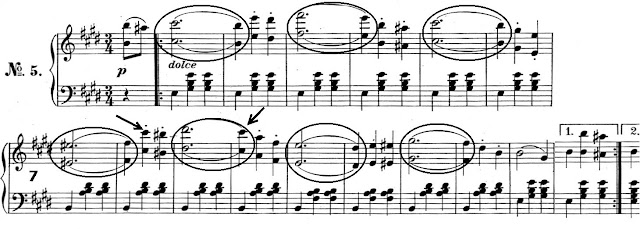Lanner, Trennungs-Walzer (1828), op19_n5, first strain. A curiously reversed resolution in bars 9-10. The circles throughout the strain show the overwhelming dissonance-resolution motive. In bars 9-10, however, the third of the underlying chord (D#5/D#6) is resolved to the ninth C#5/C#6!
Lanner, Flora-Walzer, op33_n4, first strain. Scale degree ^6 is a melodic element in each instance.
Lanner, Redout-Carneval-Tänze (second set; 1830), op42_n5, first strain. Similar to op19n5 in its motive, but now there is no "mistake" about the resolution of ^6.
Lanner, op19_n2. As in the previous example.
Lanner, op33_n4, second strain. Similar to one of the examples from Schubert in its sustained drive upwards culminating on the highly expressive ^6 as the ninth of the dominant.
Lanner, op42_n6. Three different treatments of the ninth, at (a), (b), and (c).
The remaining examples are all direct resolutions, that is, the ninth resolves not within the dominant but in the following tonic.
Lanner, op33_n5.
Lanner, op42_n5, second strain
Lanner, Alpen-Rosen Walzer (1842), op162 n3
Lanner, op162 n4
Lanner, Die Romantiker (1842), op167 n4










